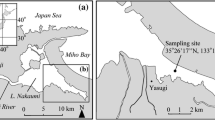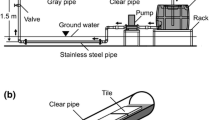Abstract
In rivers, variations in concentrations of many dissolved nutrients occur during spates. Increases are usually attributed to concentrated point or non-point inputs, and decreases to dilution associated with rainfall. Increased discharge disturbs sediments and benthic communities, but the effects of such disturbance on nutrient levels are difficult to isolate. Measurements of nutrient levels over three artificial spates revealed that substantial variations in dissolved organic carbon, dissolved phosphate, silicate, nitrate, and potassium levels could result from increased discharge in the absence of allochthonous inputs. Variations were closely related to peaks in suspended solids concentration or water height. Increases in biochemical oxygen demand and suspended bacteria also occurred.
Variations in phosphate and silicate could be accounted for by a balance between release of ‘sediment interstitial water’ and exchange processes involving suspended and freshly exposed sediment.
An increase in nitrate, during one spate, was probably due to a reduction in the effect of benthic denitrification.
Small peaks in dissolved organic matter concentration were detected over each spate.
We propose that within-stream disturbance is a factor which may contribute to variations in dissolved nutrient concentration during the rising hydrograph in natural spates.
Similar content being viewed by others
References
Allen, S. E., Carlisle, A., White, E. J. & Evans, C. C., 1963. The plant nutrient content of rainwater. J. Ecol. 56: 497–504.
Baker, J. H. & Farr, I.S., 1976. Origins, characterisation and dynamics of suspended bacteria in two chalk streams. Arch. Hydrobiol. 80: 308–326.
Baker, C. D., Bartlett, P. D., Farr, I. S. & Williams, G. I., 1974. Improved methods for the measurement of dissolved and particulate organic carbon in fresh water and their application to chalk streams. Freshwat. Biol. 4: 467–481.
Cahill, T. H., lmperato, P., Verhoff, F. H., 1974. Evaluation of phosphorus in a watershed. J. Environ. Engin. Div. ASCE. 100, No. EE2, Proc. Paper 10445, Apr. 1974, 439–458.
Carigan, R. & Flett, R. J., 1981. Post depositional mobility of phosphorus in Lake sediments. Limnol. Oceanogr. 26(2): 361–366.
Casey, H., 1969. The chemical composition of some southern English chalk streams and its relation to discharge. Ass. River Authorities Yb 1969, 100–113.
Casey, H., 1975. Variation in the chemical composition of the River Frome, England, from 1965 to 1972. Freshwat. Biol. 5: 507–514.
Casey, H., 1977. Origin and variation of nitrate nitrogen in the chalk springs, streams and rivers in Dorset and its utilisation by higher plants. Progve Wat. Tech. 8, Nos 4/5: 225–235.
Casey, H. & Clarke, R. T., 1979. Statistical analysis of nitrate concentrations from the River Frome (Dorset) forthe period 1965–76. Freshwat. Biol. 9: 91–97.
Casey, H., Clarke, R. T. & Marker, A. F. H., 1981. The seasonal variations in silicon concentrations in chalk streams in relation to diatom growth. Freshwat. Biol. 11: 335–344.
Casey, H. & Newton, P. V. R., 1973. The chemical composition and flow of the River Frome and its main tributaries. Freshwat. Biol. 3: 317–333.
Casey, H. & Westlake, D. F., 1974. Growth and nutrient relationships of macrophytes in Sydling Water, a small unpolluted chalk stream. Proc. Eur. Weed Res. Coun. 4th int. Symp. Aquatic Weeds (1974). Vienna, pp. 69–76.
Clark, C., 1978. Sediment dynamics of a small upland catchment. Ph.D. thesis, Exeter University. 429 pp.
Cooke, G. W. & Williams, R. J. B., 1973. Significance of manmade sources of phosphorus: fertilisers and farming. Water Res. 7: 19–33.
Davies, A. E., 1971. Changes in water quality associated with storm hydrographs. M.Sc. thesis, University of Newcastle-upon-Tyne. 284 pp.
Harms, L. L., Vidal, P. H. & McDermott, T. E., 1978. Phosphorus interactions with stream sediments. J. Env. Engng, Div. A, 104, Paper No. 13682: 271–288.
Kemp, L. E., 1968. Phosphorus in flowing waters. Water Res. 2: 373–386.
Ladle, M., 1971. The biology of Oligochaeta from Dorset chalk streams. Freshwat. Biol. 1: 83–97.
Ladle, M., Baker, J. H., Casey, H. & Farr, I.S., 1976. Preliminary results from a recirculating experimental system: observations on interactions between chalk stream water and inorganic sediment. In: Golterman, H. L. (Ed.) Proc. Int. Symp. Amsterdam, pp. 252–257. Dr. W. Junk, The Hague.
Ladle, M., Bass, J. A. B. & Jenkins, W. R., 1972. Studies on production and food consumption by the larval Simuliidae (Diptera) of a chalk stream. Hydrobiologia 30: 429–448.
Marker, A. F. H., 1976. The benthic algae of some streams in southern England. I. Biomass of the epilithon in some small streams. J. Ecol. 64: 343–358.
Marker, A. F. H. & Casey, H., 1982. The population and production dynamics of benthic algae in an artificial recirculating hard-water stream. Phil. Trans. Roy. Soc. Lond. (in press).
Omernick, J. M., 1976. The influence of land use on stream nutrient levels. EPA-600/3–76. 014. U.S. Environmental Protection Agency, Washington, D.C. 106 pp.
Owens, M., 1970. Nutrient balances in rivers. Water Treat. Exam. 19: 237–252.
Owens, M., Garland, J. H. N., Hart, I.C. & Wood, G., 1972. Nutrient budgets in rivers. Symp. Zool. Soc., Lond. No. 29: 21–40.
Reeder, S. W., Hitchon, B. & Levinson, A. A., 1972. Hydrochemistry of the surface waters of the Mackenzie River drainage basin, Canada. I. Factors controlling inorganic composition. Geochim. cosmochim. Acta 36: 825–865.
Stake, E., 1967. Higher vegetation and nitrogen in a rivulet in central Sweden. Schweiz. z. Hydrol. 29: 107–124.
Sylvester, R. O., 1961. Nutrient content of drainage water from forested, urban and agricultural areas. Algae and Metropolitan wastes. SEC-TR-W61–3. U.S. Dept. of Health, Education and Welfare, Washington 80–87.
Welton, J. S., 1980. Dynamics of sediment and organic detritus in a small chalk stream. Arch. Hydrobiol. 90, (2): 162–181.
White, E., Starkey, R. S. & Saunders, M. J., 1971. An assessment of the relative importance of several chemical sources to the waters of a small upland catchment. J. appl. Ecol. 12: 743–749.
Zeman, L. J. & Slaymaker, O., 1973. Mass balance model for calculating of ionic input loads from atmospheric fallout and discharge from a mountainous basin. Hydrol. Sci. Bull. 23, 1: 103–117.
Author information
Authors and Affiliations
Rights and permissions
About this article
Cite this article
Casey, H., Farr, I.S. The influence of within-stream disturbance on dissolved nutrient levels during spates. Hydrobiologia 91, 447–462 (1982). https://doi.org/10.1007/BF02391959
Issue Date:
DOI: https://doi.org/10.1007/BF02391959




